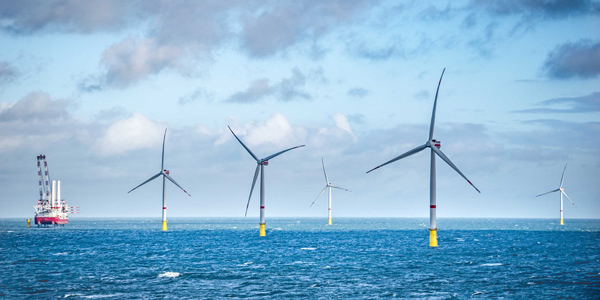By Michael Kuser
Massachusetts and Rhode Island on Wednesday awarded procurements for 1,200 MW of offshore wind energy from what will become the two largest offshore projects in the U.S.
Vineyard Wind, a partnership between Avangrid Renewables and Copenhagen Infrastructure Partners, won the contract to supply Massachusetts with 800 MW of offshore wind energy, while Rhode Island selected Deepwater Wind to build the 400-MW version of the company’s Revolution Wind proposal.
Financial details for the fixed-price bids have not been disclosed.
“With today’s landmark decisions, Massachusetts and Rhode Island are ready to pioneer large-scale offshore wind development that will light the way for our industry and nation,” American Wind Energy Association CEO Tom Kiernan said in a statement. “With world-class wind resources, infrastructure and offshore energy expertise, the U.S. is primed to scale up this industry and lead it.”
Also on Wednesday, New Jersey Gov. Phil Murphy signed legislation codifying his commitment to build 3,500 MW of offshore wind by 2030, surpassing New York’s target of 2,400 MW. (See related story, Gov. Signs NJ Nuke Subsidy, Renewables Bills.)
Fast Start
“Vineyard Wind is proud to be selected to lead the new Massachusetts offshore wind industry into the future,” company CEO Lars Thaaning Pedersen said Wednesday. “Today’s announcement reflects the strong commitment to clean energy by Gov. [Charlie] Baker and the Massachusetts legislature.”
The Vineyard project will lie about 15 miles south of Martha’s Vineyard and include a transmission component linking back to the ISO-NE grid.
The company plans to begin construction in 2019 and start operating the first 400-MW section of the project by 2021, with the second half slated for completion in 2022. It got a head start on its rivals in the solicitation by beginning state and federal permitting processes in December and submitting the project’s draft environmental impact statement with state regulators on May 1.
Vineyard has said its project would generate 3,600 jobs, including 1,500 coming with the start of onsite construction. The company has also promised the project will yield significant CO2 reductions, displacing 1.25 million metric tons per year upon full operation in 2022.
Massachusetts Sierra Club Director Emily Norton called Wednesday’s announcement “terrific news” but said it is only the beginning.
“With the cost of offshore wind falling precipitously, we can transition much more quickly to 100% clean energy than anyone thought possible, and there is no time to lose,” Norton said.
“This is such an important milestone. Rather than drilling for oil and gas off of the New England coast, we will find our energy future blowing in the wind,” U.S. Sen. Ed Markey (D) said on Twitter.
In December, three developers — Vineyard, Deepwater and Bay State Wind — submitted bids in the request for proposals (83C), which called for a minimum of 400 MW but said the state would consider bids of up to 800 MW if it determined that a larger proposal was both superior to other proposals and “likely to produce significantly more economic net benefits to ratepayers.”
All three developers purchased renewable energy leases off the coast from the U.S. Bureau of Ocean Energy Management.
Massachusetts’ 2016 Act to Promote Energy Diversity mandated the Department of Energy Resources and the state’s distribution utilities — Eversource Energy, National Grid and Unitil — to sign long-term contracts for 1,600 MW of offshore wind by June 30, 2027. All three utilities had a hand in the selection, and an independent evaluator monitored and assisted the bid evaluation process.
Transmission Backbone
Deepwater Wind’s 400-MW project will connect to land at the Brayton Point substation in Somerset, Mass., and the company partnered with National Grid Ventures to propose an offshore transmission “backbone” scalable to 1,600 MW that would be open to other wind developers. (See Offshore Wind Developers Ponder Tx Options.)
The Revolution project will firm its output through an agreement with the largest hydroelectric pumped storage facility in New England, the 1,200-MW Northfield Mountain station operated by FirstLight Power Resources.
The company’s bid said its grid-scale storage and expandable transmission system would “result in energy market savings of $75 million annually for Massachusetts ratepayers, without counting the benefits of economic development or emissions reductions.”
Deepwater developed the first offshore wind farm in the U.S., the 30-MW Block Island project in Rhode Island, which began commercial operation in December 2016.
“Rhode Island pioneered American offshore wind energy, and it’s only fitting that the Ocean State continues to be the vanguard of this growing industry,” said Deepwater Wind CEO Jeffrey Grybowski. “We applaud Gov. [Gina] Raimondo for her bold commitment to a clean energy future.”




